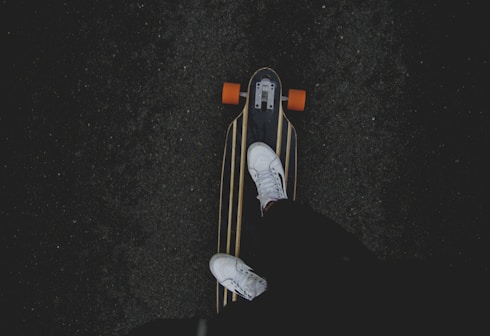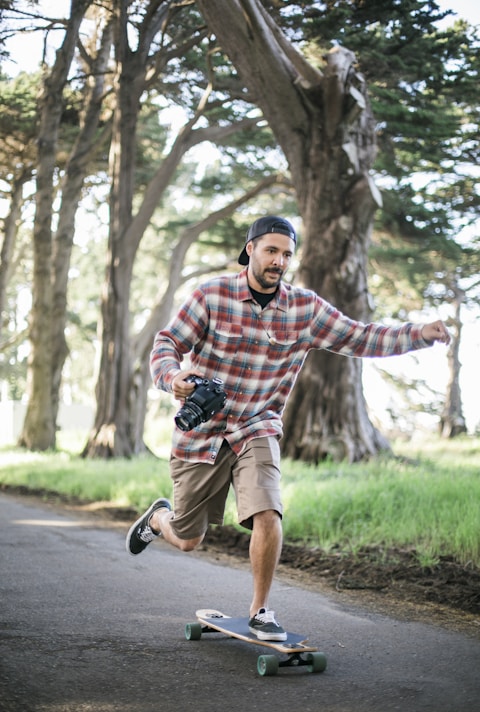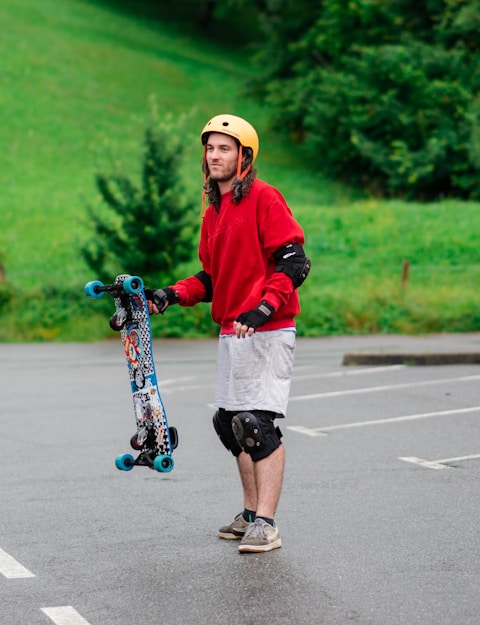A beginner's guide to longboarding: Are longboards easy to learn on?
Are longboards good for beginners? Our guide reveals all! Get tips and advice to start your longboarding journey with ease. Gain the confidence to master longboarding.
OPINION
9/13/20239 min read


Longboarding is an exhilarating sport that has been gaining popularity over the last few years. It's a great way to get outside and enjoy the outdoors while getting some exercise. But a common question many people have is, are longboards easy to learn on? In this beginner's guide to longboarding, we'll be exploring how easy it is to pick up longboarding, and provide some helpful tips to get you started.
The Basics of Longboarding
Longboarding is a thrilling and exciting sport that has captured the attention of many outdoor enthusiasts in recent years. If you've ever watched someone effortlessly glide down the street on a longboard, you may have found yourself wondering how easy it is to learn this exhilarating activity. In this section, we will dive into the basics of longboarding, giving you the essential knowledge you need to get started on your longboarding journey.
So, what exactly is a longboard? A longboard skateboard is a longer and wider version of a traditional skateboard. These boards are specifically designed for cruising and carving, making them perfect for some beginner skateboarders. The wider deck and larger wheels of a longboard provide a little more stability and control, allowing riders to comfortably ride over longer distances and at higher speeds.


To begin your longboarding adventure, it's important to find the right longboard for you. Longboard decks come in various shapes and sizes, each suited to different riding styles and preferences. Pintail longboards, for example, are great for beginners due to their stability and maneuverability. Drop-through and drop-down longboards are better for downhill riding and freeriding, offering more control and stability at higher speeds. Take the time to research and test out different longboards to find the one that suits your needs and riding style.
Once you have your longboard, it's time to familiarize yourself with the basic riding techniques. Start by finding a smooth and flat area to practice on, such as an empty parking lot or a quiet neighborhood street. Position your feet perpendicular to the longboard, with your front foot pointing towards the front of the board and your back foot resting on the tail. Push off with your back foot to gain some initial speed and then place it back on the board. This motion is called pushing, and it helps you generate momentum and maintain balance.
As you gain confidence and become more comfortable on your longboard, you can start exploring different riding techniques and tricks. Experiment with carving, which involves leaning into turns to navigate corners smoothly. Learn how to perform slides, which allow you to control your speed and change directions quickly. Mastering these basic skills will not only enhance your longboarding experience but also prepare you for more advanced techniques in the future.
Building Speed and Momentum
Once you've mastered the basics of longboarding and gained confidence in your balance and control, it's time to focus on building speed and momentum. Building speed on a longboard is an exhilarating feeling that allows you to cover more ground and experience the true thrill of longboarding. In this section, we'll explore some techniques and tips to help you build speed and momentum on your longboard.
One of the key factors in building speed is finding the right location to practice. Look for smooth and flat surfaces, such as long, open roads, parking lots, or skate parks. Avoid areas with rough terrain or obstacles that can impede your speed and control. Smooth asphalt or concrete surfaces provide optimal traction, allowing you to maximize your speed.
When it comes to building speed, your pushing technique plays a crucial role. Pushing efficiently and effectively will help you generate momentum and maintain a steady speed. Make sure to push with your back foot in a smooth and controlled motion. Use your front foot to stabilize and guide the board, ensuring a consistent and powerful push with each stride.
Another technique to build speed is by utilizing hills. Longboarding downhill can provide an incredible rush of adrenaline and help you reach higher speeds. However, it's important to approach downhill riding with caution, especially as a beginner. Start with smaller hills and gradually work your way up to steeper slopes as you become more comfortable and confident. Remember to keep your weight evenly distributed, leaning slightly back to maintain balance and control.
Carving is another effective technique to build speed and momentum on your longboard. Carving involves making wide, sweeping turns while shifting your weight from side to side. By leaning into your turns and using your body to generate force, you can propel yourself forward and maintain a continuous flow of speed. Practice carving on wide open spaces to get the hang of it, and gradually increase your speed and the tightness of your turns.


Lastly, your longboard setup can also contribute to your speed and momentum. Experiment with different longboard decks and wheel sizes to find the setup that suits your needs. Longboard decks come in various shapes and sizes, each designed for specific riding styles and preferences. Opt for longer decks with larger wheels for increased stability and speed. Additionally, high-quality bearings can greatly enhance your speed and smoothness of your rides.
Building speed and momentum on your longboard is an exciting and rewarding experience. By utilizing proper pushing techniques, utilizing hills, practicing carving, and finding the right longboard setup, you can reach exhilarating speeds and enjoy the full potential of longboarding. Remember to always prioritize safety and gradually work your way up to higher speeds as you become more comfortable and confident in your abilities.
Practicing Basic Skills
Practicing basic skills is an essential part of becoming a proficient longboarder. Whether you're a beginner or have some experience, honing your fundamental techniques will not only improve your overall riding ability but also enhance your confidence on the board. In this section, we'll explore some key skills to practice to become a better longboarder.
One of the first basic skills to master is foot placement. How you position your feet on the longboard can greatly impact your control and stability. As mentioned earlier, a good starting position is to have your front foot pointing towards the front of the board and your back foot resting on the tail. However, everyone has different preferences, so it's important to experiment and find the stance that feels most comfortable for you.
Next, let's talk about pushing. Pushing is the act of using your foot to propel yourself forward and generate momentum. To push properly, place your back foot on the ground and push off with a smooth and controlled motion. Remember to keep your weight balanced and centered as you push, and use your front foot to stabilize and guide the board. Practice pushing on flat surfaces and gradually increase your speed and distance to improve your technique.
Another essential skill to practice is turning. Being able to navigate corners smoothly is crucial for both safety and maneuverability. To turn on a longboard, shift your weight in the direction you want to go and lean into the turn. Start with small turns and gradually increase the tightness of your turns as you become more comfortable. Remember to use your body and your feet to initiate and control the turn.
Once you've mastered basic turning, you can start practicing more advanced turning techniques, such as carving. Carving involves making wide, sweeping turns while shifting your weight from side to side. It's a fun and efficient way to generate speed and maintain momentum. Practice carving on open spaces, focusing on your body positioning and the fluidity of your movements.
Lastly, practicing your balance and stability is crucial for becoming a skilled longboarder. Try riding on one foot to improve your core strength and balance. Lift one foot off the board and balance on the other, gradually increasing the duration as you become more comfortable. This exercise will not only improve your balance but also enhance your overall control on the board.
Remember, practicing basic skills is a continuous process. The more time you spend on your longboard, the better you'll become. Don't be afraid to experiment, make mistakes, and challenge yourself. With dedication and persistence, you'll develop the necessary skills to enjoy the thrill and freedom that longboarding offers. So grab your longboard, find a safe and open space, and start practicing those basic skills today!


Advanced Techniques
Once you have mastered the basics of longboarding and gained confidence in your balance and control, it's time to take your skills to the next level with some advanced techniques. These techniques will not only elevate your longboarding experience but also allow you to push the boundaries of what you thought was possible on a longboard. In this section, we will explore some exciting advanced techniques that will take your longboarding skills to new heights.
One of the most thrilling advanced techniques in longboarding is sliding. Sliding involves intentionally breaking traction with your wheels, allowing you to control your speed and change directions quickly. To execute a slide, start by shifting your weight towards the back of the board and initiating a controlled drift by applying pressure on the edges of your board. This will cause the wheels to break loose, allowing you to slide sideways. As you become more comfortable with sliding, you can experiment with different types of slides, such as the stand-up slide or the Coleman slide. Sliding adds a new level of control and style to your longboarding, making it a favorite among experienced riders.
Another advanced technique to master is downhill riding. Descending steep hills at high speeds requires a different set of skills and a heightened level of focus. When riding downhill, it's essential to maintain a low center of gravity and use your body to stabilize and control the board. Gradually increase your speed as you become more comfortable, and remember to use your body to shift your weight and initiate turns. Advanced riders often incorporate carving techniques into their downhill riding, allowing them to maintain speed while navigating tight corners. However, it's crucial to approach downhill riding with caution and wear the appropriate safety gear, such as a helmet and knee pads, to protect yourself from potential falls or collisions.
Freestyle longboarding is another exciting aspect of the sport that allows riders to express their creativity and style. Freestyle longboarding combines elements of street skateboarding with the flow and grace of longboarding. Tricks such as manuals, slides, and flips are commonly performed in freestyle longboarding, adding an extra level of technicality and finesse to your riding. To get started with freestyle, practice basic tricks such as manuals and pivots, gradually progressing to more advanced tricks like shuvits or kickflips. Freestyle longboarding allows you to showcase your individuality and truly make the board your own.
As you continue to progress as a longboarder, it's important to challenge yourself and explore new techniques. Take inspiration from other riders, watch tutorial videos, and join local longboarding communities to learn from experienced riders. Always remember to prioritize safety and wear appropriate protective gear when attempting advanced techniques.
Safety Tips for Longboarding
Safety is always a top priority when it comes to any sport or activity, and longboarding is no exception. Whether you're a beginner or an experienced rider, it's crucial to follow safety guidelines to ensure a fun and injury-free longboarding experience. In this section, we'll provide you with some essential safety tips to keep in mind when you hit the streets on your longboard.
First and foremost, wearing protective gear is absolutely essential when longboarding. Make sure to always wear a helmet to protect your head from potential impacts. Additionally, knee pads, elbow pads, and wrist guards can provide extra protection and prevent injuries in case of a fall or collision. Don't underestimate the importance of protective gear - it can truly be a lifesaver.


Next, be aware of your surroundings and choose appropriate riding locations. Avoid busy streets, crowded areas, and areas with heavy traffic. Look for smooth and flat surfaces, such as skate parks, empty parking lots, or designated longboarding areas. Make sure the surface is clear of any obstacles, debris, or loose gravel that could cause you to lose control or trip.
When longboarding, it's important to be visible to others, especially drivers. Wear bright and reflective clothing, especially if you're riding during low-light conditions. Use lights or reflective gear on your longboard to increase your visibility and alert others to your presence on the road.
As a longboarder, it's important to follow the rules of the road and obey traffic laws. Longboards are considered vehicles in many areas, so you should ride in the same direction as traffic, obey traffic signals, and use hand signals to communicate your intentions. Be courteous to pedestrians and other cyclists, and always yield the right of way when necessary.
It's also important to be mindful of your own limitations and abilities. Don't attempt tricks or advanced maneuvers that you're not ready for, as this can increase your risk of injury. Take your time to practice and develop your skills gradually, always pushing yourself within a safe and comfortable range.
Finally, as obvious and silly as this sounds... never ride under the influence of alcohol or drugs. Longboarding requires focus, coordination, and quick reactions, and impairing these abilities can lead to accidents and injuries. Stay sober and clear-headed while riding.
By following these safety tips, you can ensure a safe and enjoyable longboarding experience. Remember to always prioritize your safety and the safety of those around you. Now that you know how to longboard safely, go out there, have fun, and enjoy the exhilarating freedom of longboarding!